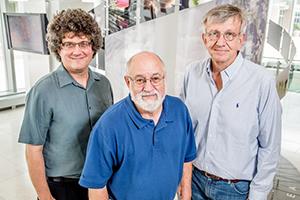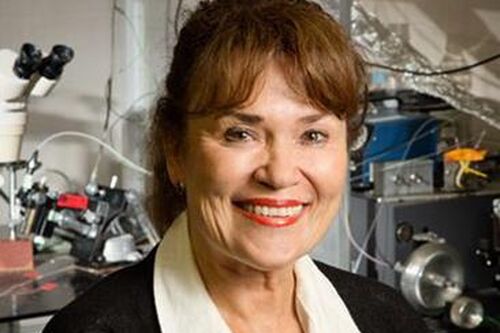The Strength of a Single Solution

One solution leads to another. Or, as protein researchers at Illinois have recently found, one solution can lead to hundreds of others—and a greater understanding of how life works.
Biochemists in the College of Liberal Arts and Sciences were amongst 15 scientists in a multidisciplinary study across three institutions to identify the function of a single, mysterious bacterial protein. In the process, the team developed a streamlined way to help identify the functions of hundreds of other proteins.
The researchers used computational methods combined with a broad array of laboratory techniques to identify the role of the protein, an enzyme called HpbD, within its host, the marine bacterium Pelagibaca bermudensis. Illinois biochemistry professor John Gerlt, one of five co-principal investigators on the study, says the goal wasn’t just to identify HpbD’s function, but to forge a new way to tackle the vast and growing body of sequence data for which functional information is lacking.
“At present, the number of proteins in the protein-sequence database is approaching 42 million,” Gerlt says. “But no more than 50 percent of these proteins have reliable functions assigned to them.”
Without knowing what all of the proteins that are encoded by a genome do, “one simply cannot understand the biology of the organism,” Gerlt says.
For this study, researchers at the University of California–San Francisco (UCSF) conducted computations that streamlined the process of protein discovery. They paired enzymes with tens of thousands of possible metabolic partners to see which molecules fit best, and then they sent the identities of four possible substrates and a likely pathway in which HpbD operates to Illinois for lab work.
Gerlt and his colleagues (microbiology professor John Cronan and chemistry professor Jonathan Sweedler, and Steven Almo at the Albert Einstein College of Medicine) discovered that HpbD catalyzes the first step in a biochemical pathway that enables the marine bacterium to use a substrate, tHypB (tee-hype-bee), as a carbon source.
More importantly, the team discovered that tHypB has another, perhaps more important, role in the bacterium: It helps the organism deal with the stress of life in a salty environment.
This effort to understand the function of one enzyme offers a cascade of other benefits, Gerlt says. One big advantage of this approach is that it aids in the identification of orthologs (enzymes that perform the same task in other organisms).
“There are dozens of orthologs in the protein database that were identified by Patricia Babbit and her colleagues at UCSF, so we determined not only the function of one but we also determined the functions of all these enzymes,” Gerlt says.
And because the researchers also identified the functions of all the enzymes in the pathway that allows the microbe to consume tHypB, their work offers insight into the role of orthologous enzymes in similar pathways in other organisms.
The research is part of the Enzyme Function Initiative at the Institute for Genomic Biology at Illinois. Funded by the National Institutes of General Medical Sciences and led by Gerlt, this initiative is designed to address complex problems—those involving bacterial enzymes in particular—at the center of biomedical science that are beyond the means of any single research group.
“There was a time when I would apologize that we were focusing on bacterial genomes and not human genomes,” Gerlt says. “However, it is now well established that we do not live in isolation, that we have a microbiome associated with us, and that microbiome is made up of thousands of different bacterial species that inhabit our bodies. It is very important for us to understand what these bacteria are capable of doing.”








